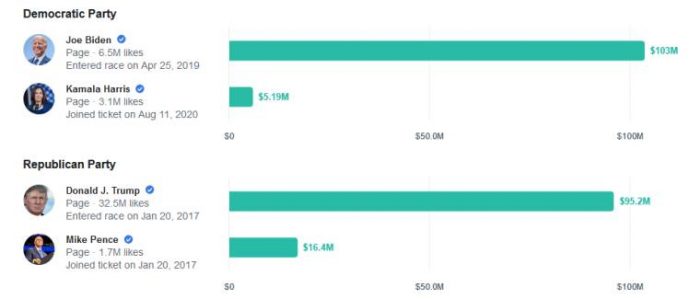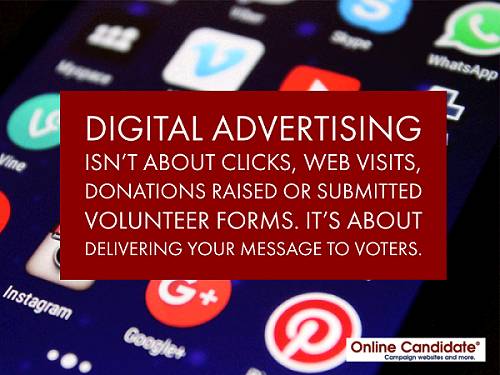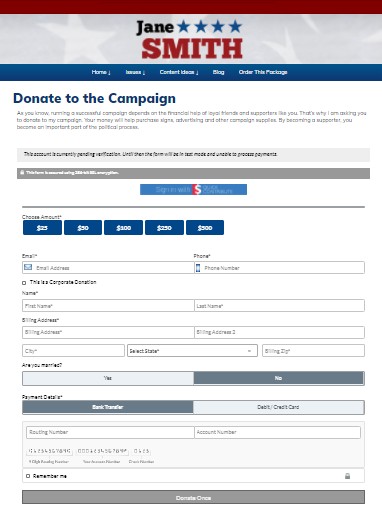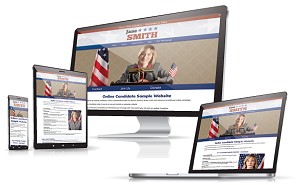Political campaigns today have many options for online advertising to reach and influence voters. Candidates can now reach out based on demographics and tailor their advertisements to particular audiences. With a low cost to entry, even local candidates can put together an effective online political marketing strategy.
- Online ad spending is way, way up over the last few election cycles. How much should you budget for digital advertising? This varies on the size of your campaign and the amount of money you have to work with.
- Online campaigning isn’t just for the big guys anymore. Local campaigns can follow almost any marketing strategy that a state and federal race can do.
- The question is, do you have the budget and resources to do it all? Odds are, you probably don’t. Sure, it would be great to put out daily videos on TikTok and maintain an extensive Pinterest board. But is it really practical for someone running for a school board or town council position to be spending time promoting themselves on those platforms?
You have to pick your online targets carefully to create publicity to the right voter audience.
A smart strategy is to start early with a few platforms and commit a small budget to see what works best. Build a reserve for your online Get Out The Vote advertising. Every campaign has a different set of challenges. Fortunately, it is easy to shift online advertising in response to new events and situations. They key is to have that money available when you need it.
There are a number of political digital marketing strategies for the web. Some are very affordable, others are more expensive. Here are some of the most popular online advertising options available today:
- Facebook Advertising
- Pay Per Click Advertising
- Local Campaign Website Advertising
- Retargeting Site Visitors
- IP Target Marketing
- Text Messaging and SMS
- Positive or Negative Advertising?
- Transparency in Online Advertising
- Your Campaign Website
Political Facebook Advertising
Political advertising on Facebook can be very effective. Facebook allows advertisers to target people based on their demographics. This means you can drive your message directly to voting-age users that match specific locations and have expressed a interest preferences.
You can promote direct advertisements or your individual Facebook posts. The minimum required budget is only a few dollars per ad, so the barrier to entry is low. Instagram is owned by Facebook, so that site is covered as well.
Following the 2016 US presidential election, there has been some controversy about Facebook promotional policies. As of 2018, advertisers pushing viewpoints on political and social issues were required to provide more disclosure about who they are. Political ads were also be labeled so users can discover more about the ads that they see.
By 2020, advertisers were required to be authorized to advertise of Facebook.

Facebook political ad library.
To buy political advertising on Facebook, you must provide personal information and verify your mailing address with Facebook. This process can take a few weeks, so start early. Generally, any ads that mention a political candidate, issue or cause must adhere to these disclosure rules.
Pay Per Click Advertising
Another digital political advertising option includes Pay Per Click (PPC) advertising. Your best bet for Pay Per Click advertising is Google Ads. For branding, larger political campaigns often advertise on more than just the search engines. They will also allow their ads to appear on the Google Display Network which encompasses thousands of websites.
It’s easy to spend money on irrelevant searches, so you will want to primarily target phrases and exact terms. As you discover unrelated searches that attract clicks, you should add them to your list of negative terms.

A well-designed PPC ad campaign requires planning and testing. Ads will need to be broken into groups, and then broken down further as new niches are discovered. Some ads will have low click-through rates and others will perform well. Tracking how well each ad performed in clicks, e-mail sign-ups and donations raised will help you make the most of your advertising dollars.
Display Advertising
Google also provides display ad marketing services. Unlike PPC ads, display ads are not based on user searches. Rather, these ads are graphic (image) ads that appear within the web content where a user is browsing. Your ads can appear where a user is reading news articles, checking email or watching online videos.

Example of political display ad banner
Display ads show on the Google Display Network which is a network of websites, videos, and apps. You can target by location, keyword, age and gender.
Related: What Political Campaigns Need To Know About Google Display Ads
Local Campaign Website Marketing
Banner ads are still relevant, especially when run on local media sites, such as local newspaper websites. Banners can help with branding and messaging efforts. While traditional banner ads often have low click-through rates, they can help build name recognition to a local audience. The cost for banner ads varies with the market and the outlet.
If you plan to run online ads directly through a newpaper, you may want to reserve your ad inventory early.
Retargeting Site Visitors
Retargeting allows you to serve display (banner) ads to people who have visited your campaign website. Once an established tool reserved for national politics, is it now used in local and regional campaigns. Visitor retargeting can help serve ads to voters who are actively researching candidates.
Retargeting can help keep interested voters engaged throughout the campaign, helping to increase awareness and voter turnout.

These are the step for how political retargeting works.
You can even set up retargeting down the page level. One example is if a voter goes to a particular issue page, you can retarget them with an ad specific to that issue. One of the primary benefits of retargeting is that ability to show different messages to different types of visitors. This improves your digital ad relevancy and effectiveness.
You can set up retargeting through Facebook Remarketing and Google Remarketing. However, these programs can be complicated to set up. You may find it easier to set up remarketing campaigns through a third-party platform.
Related: How Does Retargeting Grow Your Political Campaign?
IP Targeting Voters By Location and Demographics
IP Targeting uses individual IP addresses to reach specific voter households. It works by matching IP addresses to a list of names and street addresses. Your ads reach the target households and display your ads on websites they visit across the internet, like news sites. IP targeting is superior to geo-targeting because it allows you to target your advertising to specific households and businesses.
You can tailor your advertising messaging to individual audiences for greater impact and response. Because of this, IP-targeted ads have higher click-through rate than PPC or retargeting campaigns.
Using demographic data, you can tailor and target messaging for a specific audience for greater impact and response.
The price for IP targeting is higher than other promotional methods, but its branding ability is powerful. For example, we’ve had clients who used IP targeting in conjunction with neighborhood canvassing. Some of the homeowners would recognize the candidate because they had seen their ads already while online.
Talk about reinforcing a message!

Learn how IP Targeting can enhance your voter outreach.
Text Messaging and SMS
Text messaging and SMS is not just for candidates with deep pockets. Mobile texting services can be started with a small budget as little as $20/month. Some SMS services offer widgets that can allow supporters to sign up for text updates directly through your campaign website or Facebook page. Start early and build up a supporters who can be instantly alerted to new campaign announcements and messages.
Related: Drive Traffic to Your Website with Text Messages
Positive or Negative Online Advertising?
Negative political advertising is not just limited to TV and direct mail. As far as effectiveness, the jury is still out on whether “going negative” pays off. Unfortunately, most voters have come to expect mud-slinging as part of the usual discourse.
And many times, going negative just works…

Transparency in Online Political Advertising
As noted above, social media platforms and search engines are demanding more transparency from their advertisers. If you plan to advertise on a certain platform, make sure you know what information is required before you run any ads. Give yourself enough time to become properly verified.
If you plan to run display ads on Facebook, Google or through IP Targeting services, they are required to disclaimer information about the campaign. This is usually something along the lines of, “Paid for by”. You will need use a disclaimer if you are a candidate, a political party or even election committee. At some point, the FEC might make disclosures mandatory.
Your Campaign Website
All online advertising must point somewhere. Your campaign website is where you will drive the bulk of your online traffic. Create specific landing pages for your different ad campaigns. For example, if you are advertising about a specific issue, send visitors to a page about that issue. Unless it’s a generic awareness ad, make the landing pages match your ads.
For landing pages, try to make them focused on exactly what you want your visitor to do. If it’s a donation page, there should be little else to distract from that single goal. Every element of the page should focus on getting the visitor to do what you want them to do.

Sample Political Donation Form
It’s important that the content a visitor sees on your site relates to the ad they clicked on. If not, visitors tend to leave quickly. Tracking your advertising channels to learn what advertising is performing best and providing the most engaged visitors, donations and volunteer signups.
Old-timers may remember when online ads were a lot less expensive. At one time, Google search results did not list four ads on top of natural search results – and those ads could have cost as little as fifteen cents. And most followers on Facebook would actually see your posts without you having to ‘boost’ them.
It’s a different world today. If you want online exposure, you will need to pay for it.
Not every organization will want to use (or can afford) to use all types of digital marketing campaigns.
Once you begin promoting yourself or your organization online, you should keep track of how well each political digital marketing channel performs. Run multiple ads at one time to determine which is more effective. This can help improve your messaging and effectiveness as you approach Election Day.
With some planning and a budget, you can increase voter exposure and run circles around your opponents. It’s a two-front battle – online and offline.
RELATED:
Political Social Media Strategies [PDF]
Political Campaign Services
For campaign websites and digital political advertising services, get started today with Online Candidate.
« When To Use IP Targeting for Your Political Campaign9 Tips For More Effective Political Banner Ads »
Tags: campaign promotion






